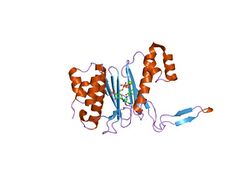Biology:4'-phosphopantetheinyl transferase
| ACPS | |||||||||
|---|---|---|---|---|---|---|---|---|---|
 crystal structure of the 4'-phosphopantetheinyl transferase sfp-coenzyme a complex | |||||||||
| Identifiers | |||||||||
| Symbol | ACPS | ||||||||
| Pfam | PF01648 | ||||||||
| InterPro | IPR008278 | ||||||||
| SCOP2 | 1qr0 / SCOPe / SUPFAM | ||||||||
| |||||||||
In molecular biology, the 4'-phosphopantetheinyl transferase superfamily of proteins transfer a 4'-phosphopantetheine (4'-PP) moiety from coenzyme A (CoA) to an invariant serine in an acyl carrier protein (ACP), a small protein responsible for acyl group activation in fatty acid biosynthesis. This post-translational modification renders holo-ACP capable of acyl group activation via thioesterification of the cysteamine thiol of 4'-PP.[1] This superfamily consists of two subtypes: The ACPS type such as E. coli ACPS and the Sfp type such as B. subtilis SFP. The structure of the Sfp type is known,[2] which shows the active site accommodates a magnesium ion. The most highly conserved regions of the protein are involved in binding the magnesium ion.
References
- ↑ "Cloning, overproduction, and characterization of the Escherichia coli holo-acyl carrier protein synthase". J. Biol. Chem. 270 (42): 24658–61. October 1995. doi:10.1074/jbc.270.42.24658. PMID 7559576.
- ↑ "Crystal structure of the surfactin synthetase-activating enzyme sfp: a prototype of the 4'-phosphopantetheinyl transferase superfamily". EMBO J. 18 (23): 6823–31. December 1999. doi:10.1093/emboj/18.23.6823. PMID 10581256.

